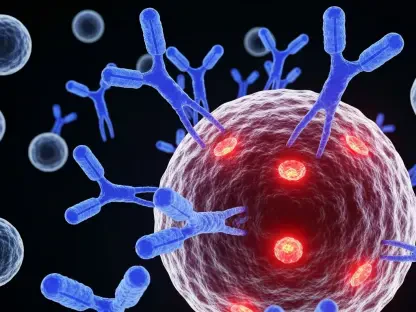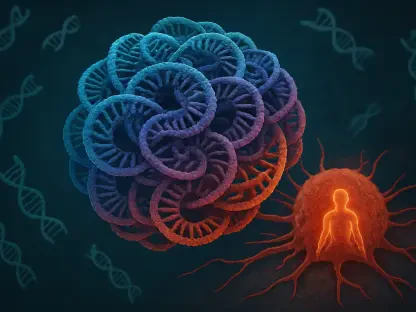In the rapidly evolving landscape of oncology, cancer vaccines have begun to emerge as pivotal players in the fight against solid tumors. As medical research continues to advance, innovative approaches are being explored to counteract the mechanisms by which cancer cells evade immune system detection. This discussion delves into a dual-targeted vaccine developed by IO Biotech, aimed at tackling these evasive tactics, particularly in the context of advanced-stage melanoma. The challenge of overcoming immune suppression within the tumor microenvironment (TME) presents significant hurdles, as TME often contains immune-suppressive cells that thwart the efficacy of traditional cancer therapies. Against this backdrop, IO Biotech’s novel dual-peptide cancer vaccine offers hope for a breakthrough in immunotherapy, potentially revolutionizing treatment protocols for various solid tumors.
Dual-Targeted Approach
Fighting Mechanisms of Cancer Cells
The complexity of cancer lies in its ability to manipulate the immune system. As cancer cells spread, they employ strategies to suppress immune responses, particularly targeting T cells. These cells are crucial defenders of the body, constantly seeking and destroying cancerous cells. Cancer vaccines aim to bolster the immune system’s capabilities by enhancing its cell recognition and attack strengths. One prominent place of concern is the tumor microenvironment, where regulatory immune cells coexist with tumor-associated macrophages. These cells contribute to the suppression, making immune responses less effective against cancer. IO Biotech has set a precedent by innovatively targeting both the suppressive immune cells and the tumor cells themselves through its cutting-edge vaccine technology, effectively aiming at both the cause and the effect.
Targeting Antigens for Immune Modulation
IO Biotech’s IO102-IO103 vaccine introduces a novel approach by addressing two antigens associated with cancer mechanisms: indoleamine 2,3-dioxygenase 1 (IDO1) and programmed death ligand 1 (PD-L1). These antigens are present in both tumor cells and certain immune cells that contribute to evading immune attacks. The vaccine, therefore, targets these antigens simultaneously, fostering a dual mode of attack. IDO1 is known for its role in immune suppression, while PD-L1 is involved in inhibiting the activation of T cells. By focusing on these targets, the IO102-IO103 vaccine enhances T cell activity and reduces immune suppression in the tumor microenvironment. This dual modality is showing promise in combating metastatic melanoma and other solid tumors, setting the stage for potentially transformative changes in cancer treatment.
Clinical Trials and Efficacy
Promising Results from Early Trials
Recent presentations at leading cancer research forums highlight the vaccine’s mechanism of action and its promising outcomes. Phase 1/2 trials showed encouraging results when the dual-peptide vaccine was combined with nivolumab, enhancing progression-free survival rates significantly in patients with metastatic melanoma. This combination therapy demonstrated a marked improvement over traditional single-agent treatments. The response rates and the vaccine’s ability to create favorable gene expression profiles in tumors were noteworthy. These findings are pivotal, considering the chronic challenges posed by immune suppression within the tumor microenvironment. With Phase 3 clinical trials underway, the medical community is eagerly awaiting further validation of these outcomes. The trials are crucial in determining whether such high efficacy can be replicated consistently, thus confirming its potential as a new standard in cancer treatment protocols.
Addressing Safety Concerns
Safety is paramount in cancer treatments, often marred by toxicities that compromise patient well-being. IO Biotech’s dual-peptide vaccine has so far maintained a clean safety profile, an aspect that could set it apart in cancer therapy innovations. Unlike many other treatments, its systemic toxicity does not exceed expectations of existing combinative treatments like pembrolizumab, rendering it a safer alternative without compromising effectiveness. This opens avenues for its use beyond melanoma, potentially across a range of other solid tumors. Maintaining a favorable safety profile is integral as the vaccine moves through advanced clinical trials, ensuring the treatment’s accessibility and application across diverse patient groups. The promise of effective treatment without heavy adverse effects might fundamentally shift the approach in cancer therapeutics, aligning efficacy with quality patient care.
Expanded Research and Challenges
Looking Beyond Melanoma
The broader expression of IDO1 and PD-L1 in various tumor types has prompted research into extending the vaccine’s application beyond melanoma. Phase 2 basket studies are exploring combinative use with pembrolizumab across multiple cancers like non-small cell lung cancer, squamous cell carcinoma of the head or neck, and urothelial bladder cancer. These clinical inquiries are crucial for gauging the vaccine’s broader effectiveness, potentially expanding its application to other prevalent cancer types. The versatility of the vaccine to target widespread tumor markers reinforces the potential of a single therapeutic to transcend multiple cancer types. However, each cancer presents its unique challenges and demands specific investigative focus to understand how combined therapies might effectively mitigate those hurdles.
Tackling Wider Tumor Ecosystems
Aside from targeting specific tumor markers, researchers are venturing into broader cancer ecosystems to uncover additional therapeutic targets. Addressing pathways like TGF-β, known for systemic inhibition challenges, offers further innovative measures in cancer treatment. Though this pathway is prominent in silencing immune responses, targeting it can minimize adverse effects while enhancing therapeutic outcomes. This exploration advocates a new frontier in vaccine and therapy development—one that leverages specific immune pathways to optimize treatment efficacy. Research into systemic pathways and their modulation holds great promise, offering ways to integrate personalized approaches into cancer care. Examining and overcoming systemic suppression is key to expanding therapeutic potentials, broadening the spectrum of possible interventions that go beyond singular tumor targets.
Integrating Microbial Insights
Exploring Cancer and Microbiome Interactions
Recent investigations are shedding light on the role of microbiomes in cancer treatment, adding another dimension to understanding tumor ecosystems. Studies suggest that dietary habits can significantly impact microbial communities, particularly within the gut and tissue environments like breast tissue. Microbial alterations are believed to influence cancer progress and treatment efficacy, highlighting the intersection between lifestyle choices and medical interventions. Researchers are particularly interested in how endocrine-targeting therapies can reshape microbiome environments to offer protective benefits. Leveraging beneficial bacteria like Lactobacillus has the potential to enhance treatment outcomes and aid in cancer prevention. This microbial approach suggests that a holistic view incorporating lifestyle factors alongside medical treatments could optimize cancer care strategies significantly.
Considerations for Future Therapies
As the exploration of microbiome interactions continues, understanding the systematic interplay between cancer, immune modulation, and microenvironment changes remains crucial. Optimizing therapy blending microbiome insights with targeted vaccine approaches can enhance overall cancer care by reducing resistance and improving prognosis. Considering microbiomes as integral elements in therapy design offers novel insights for tailored treatments, potentially paving paths for personalized medicine innovations. Aligning traditional cancer therapies with microbiome modulation strategies may reduce side effects while enhancing the effectiveness of medical interventions. Looking ahead, these holistic strategies could redefine the boundaries of current treatments and extend their reach into comprehensive cancer management solutions.
Route to Advanced Cancer Treatment
Collaborative Research Potential
Collaboration between researchers across different domains is key to progress in developing effective cancer therapies. Combining insights from vaccine innovations, microbiome studies, and systemic immune pathway disruptions marks a pivotal moment in cancer research. The potential for integrated therapeutic approaches allows for tackling multiple facets of cancer progression, optimizing treatment outcomes. As more research unfolds, collaborative efforts can accelerate the introduction of therapies that address not only the direct impacts of cancer but also the broader systemic responses. Leveraging the collective knowledge from varied fields will enhance the understanding and management of complex cancer ecosystems, potentially leading to more comprehensive care solutions.
Towards Personalized Medicine
Personalized medicine has emerged as a promising paradigm in cancer treatment, offering tailored approaches that address individual patient needs and tumor specifics. Innovations in cancer vaccines, combined with insights from genetic, lifestyle, and microbial studies, signify a shift towards personalized treatment modalities. The ability to tailor interventions based on patient-specific tumor markers, immune reactions, and microbiome interactions exemplifies a future where oncology care is optimized for individual needs. Such advancements encourage thorough, personalized assessments, ensuring that treatments are precisely aligned with unique patient profiles. The continued integration of personalized medicine principles into cancer care pathways points towards maximizing efficacy while minimizing adverse effects, ultimately contributing to improved patient outcomes and quality of life.
Future Directions in Cancer Vaccine Development
Expanding Research Horizons
The landscape of cancer vaccine development is expanding, fueled by promising results from clinical trials and innovative research. As more studies confirm the efficacy of multi-targeted approaches against solid tumors, there’s growing optimism about what future interventions might look like. Researchers are keen to uncover unique aspects of tumor biology that could be targeted for therapeutic development. By expanding focus on diverse cancer types and their complex immune interactions, more sophisticated and precise vaccines could emerge. Standardizing these treatment approaches and integrating them into existing therapeutic frameworks will ensure their effective application to diverse patient demographics, ultimately leading to more accessible and widely adopted cancer vaccine technologies.
Implications for Clinical Practice
The integration of innovative cancer vaccines presents a transformative opportunity for clinical practice, potentially shaping new standards in oncology care. As dual-targeted vaccines demonstrate efficacy across trials, they hold promise for setting new benchmarks in therapeutic outcomes, reducing resistance, and enhancing patient care. The potential for more comprehensive cancer management systems looms large, allowing for streamlined patient care pathways that incorporate vaccine applications seamlessly with existing treatments. With improved therapeutic frameworks anchored on innovative vaccine technologies, oncology professionals can anticipate shifts toward more effective care delivery. The promising implications for clinical practice spark anticipation for groundbreaking advancements that redefine cancer treatment protocols in the years ahead.
Innovative Pathways in Cancer Ecosystems
Balancing Complex Treatment Approaches
Navigating complex cancer ecosystems requires balancing innovative treatments with the realities of patient care. The challenge lies in aligning promising therapeutic interventions with practical applications while maintaining safety and efficacy. Research in immune modulation, vaccine development, and microbiome interactions presents a multifaceted approach to cancer care, requiring careful assessment and integration into treatment protocols. Oncology professionals must consider how these elements interplay and optimize therapeutic strategies that reflect evolving scientific insights. Approaching cancer care holistically ensures that new treatments are not only effective but also adaptable across diverse patient populations, providing comprehensive solutions for intricate cancer ecosystems.
Charting Course for Future Developments
The continued exploration of innovative vaccine technologies and their impact on cancer treatment presents a promising horizon for future developments. Researchers remain committed to uncovering cutting-edge solutions that address challenging cancer dynamics. As scientific endeavors evolve, a concerted focus on eliminating systemic immune suppression and optimizing therapy protocols will drive advancements. This form of collaborative and forward-thinking research is vital, providing avenues for more effective, tailored, and personalized cancer care. Charting a course towards these future developments involves persistence, innovation, and collaboration, ensuring that oncology continues to push boundaries and improve patient outcomes.
Conclusion
Collaborative efforts among scientists from diverse fields are essential to advancing the development of effective cancer treatments. By integrating advancements in vaccine technologies, studies of the microbiome, and disruptions in systemic immune pathways, cancer research enters a transformative phase. This multifaceted approach holds the promise of addressing various aspects of cancer progression, thus optimizing treatment results. As new research emerges, these collaborative initiatives can hasten the advent of therapies that combat not only the immediate effects of cancer but also broader systemic responses. Harnessing the collective expertise across various disciplines will enrich the understanding and management of complex cancer environments, paving the way for more holistic care solutions.
Moreover, teamwork among researchers fosters an environment of innovation, where breakthroughs in one field can catalyze advancements in another. Such integration is vital in crafting therapies that are more personalized and adaptive to the unique characteristics of each cancer case. Understanding how the immune system interacts with cancer cells, how microbial populations in the body influence cancer, and how vaccines can stimulate immune responses opens paths to treatments that work in concert. As research from these diverse areas converges, the potential grows for transformative solutions in cancer treatment, creating pathways to more comprehensive patient care.









